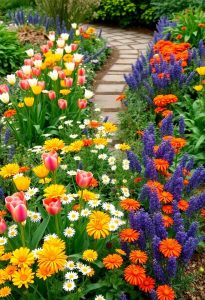Planning a seasonal flower bed is like creating a vibrant tapestry of colors throughout the year! Start by knowing your climate and hardiness zone—this helps in choosing the right flowers for each season. Think cheerful daffodils for spring, bold sunflowers for summer, and hardy marigolds for autumn! Don’t forget to sketch your layout, prepare your soil, and maintain your plants with care. Want to discover more tips and tricks to make your garden bloom? Keep exploring!
Important Highlights
- Understand your hardiness zone to choose suitable flowers for your climate and seasonal conditions.
- Plan your flower bed layout by considering sun and shade areas, and arrange flowers by height and color for visual appeal.
- Select flowers that bloom in different seasons to ensure continuous color and interest throughout the year.
- Prepare soil properly by testing pH, removing debris, and mixing in compost for optimal growing conditions.
- Maintain your flower bed by watering wisely, checking for pests, deadheading flowers, and applying mulch to retain moisture.
Understanding Your Climate and Seasonality
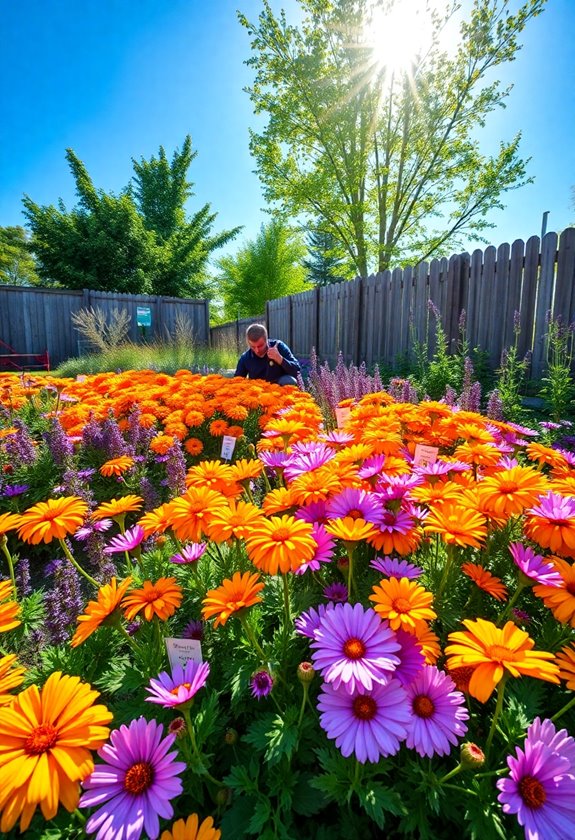
When you’re diving into the world of seasonal flower bed planning, it’s important to understand your climate and the seasons that shape it—after all, even the most beautiful blooms can struggle if they’re not suited to your environment! Have you ever wondered why some flowers thrive while others wither?
Consider these factors:
- Hardiness Zone: Know your zone to pick compatible plants.
- Frost Dates: Plant after the last frost to guarantee safety.
- Sunlight: Observe sun patterns—some flowers crave more light!
Additionally, selecting flowers that match your blooming season selection can create a vibrant and continuous display throughout the year.
Understanding these elements can save you frustration and lead to a garden that flourishes beautifully. Happy planting!
Choosing the Right Flowers for Each Season
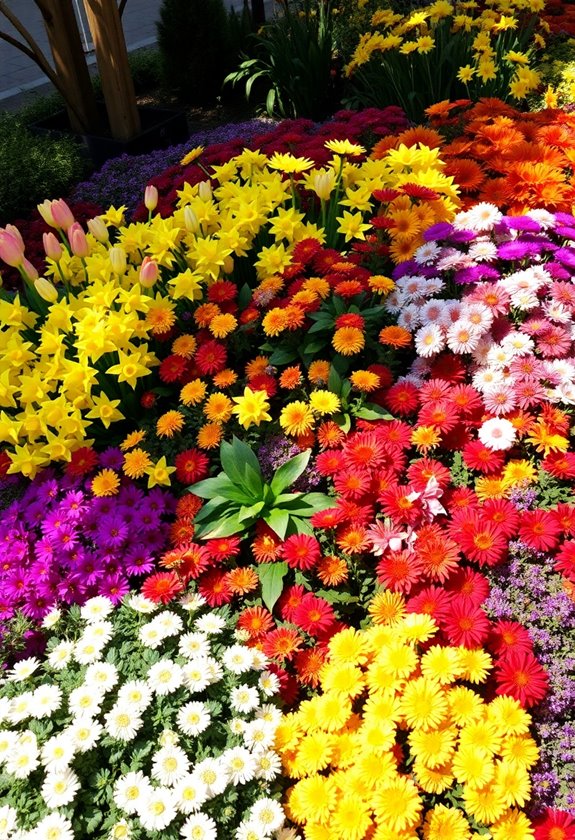
How do you choose the right flowers for each season without feeling overwhelmed? Start by exploring your local climate and picking flowers that thrive in your area. For spring, consider cheerful daffodils or tulips. In summer, vibrant sunflowers and zinnias can brighten your space. As autumn rolls in, look for hardy asters or marigolds. Finally, winter doesn’t mean bare beds; think about evergreens or winter pansies! Keep in mind your safety—avoid toxic plants if you’ve got pets or kids. Additionally, consider using pots made from quality materials to enhance the overall health of your flowers and prevent issues like root rot. Enjoy the process, and remember, gardening’s about learning and growing—just like your flowers! What’s your favorite bloom?
Designing Your Flower Bed Layout
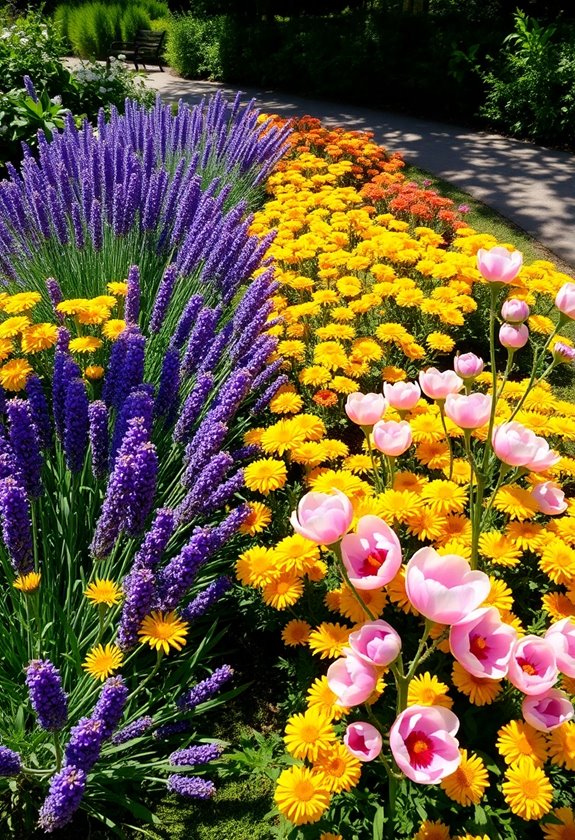
Creating a flower bed layout can feel like a thrilling puzzle, especially after picking the perfect flowers for each season! Start by sketching your space and noting the sun and shade areas—trust me, it’ll save you headaches later. Consider height; place taller flowers at the back and shorter ones in front. You might also want to think about color combinations—what looks good together? Layering textures can add depth too! Don’t forget to leave pathways for easy access. Incorporating diverse plant selection ensures your flower bed remains visually appealing throughout the year. Remember, it’s your garden, so have fun with it! Isn’t it exciting to see your vision bloom? Happy planning!
Preparing the Soil and Planting Techniques
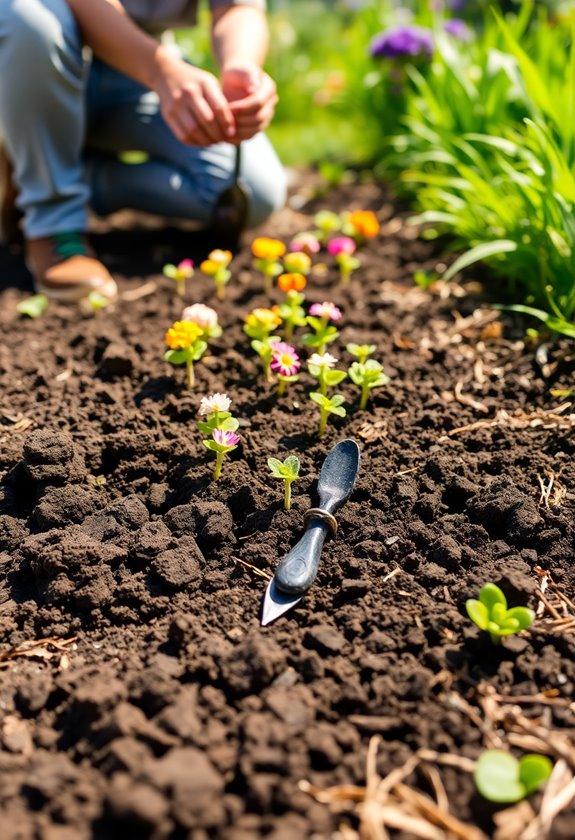
Before you even think about planting those gorgeous flowers, it’s crucial to get your soil in tip-top shape! Start by removing weeds, rocks, and debris—trust me, your flowers will thank you! Test your soil’s pH; most flowers love slightly acidic to neutral soil. Mix in compost to boost nutrients and structure.
Now, when planting, dig a hole twice as wide as your plant’s root ball. Place it in the hole, cover it with soil, and water deeply. Ever had a flower flop? It might be because of poor soil prep! To enhance your gardening success, consider using drainage features to prevent waterlogging in your flower beds. So, roll up your sleeves and plunge into that rich earth—happy planting!
Maintenance Tips for a Thriving Flower Bed

While it might seem tempting to just sit back and enjoy the beauty of your flower bed, keeping those blooms thriving requires a bit of regular TLC! First, water wisely—early mornings are best to avoid evaporation. Check for pests, too; a quick spray of soapy water can do wonders!
Don’t forget to deadhead—removing spent flowers encourages new growth. And mulch? It’s like a cozy blanket for your plants, helping retain moisture and keep weeds at bay. Using high-strength stainless steel tools can make the maintenance process more efficient and enjoyable.
Have you ever tried composting? It’s a fantastic way to enrich your soil. Happy gardening, and remember: a little care goes a long way!
Incorporating Color and Texture for Aesthetic Appeal
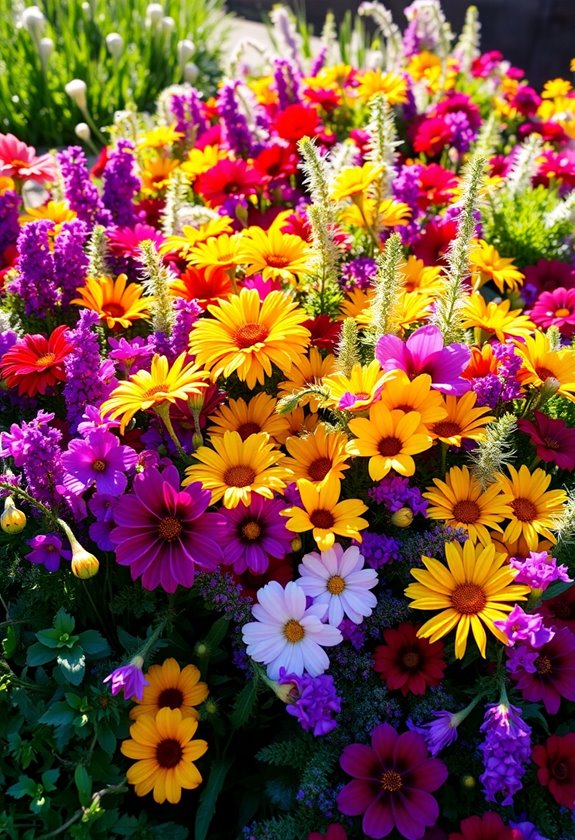
A vibrant flower bed is like a canvas waiting for your artistic touch! You can create stunning visual appeal by combining colors and textures. Think about how different flowers can interact with each other. Here are three tips to get you started:
- Choose a color palette: Go for complementary colors to create harmony.
- Mix textures: Combine smooth petals with ruffled blooms for interest.
- Layer heights: Plant taller flowers in the back and shorter ones in the front for depth.
Frequently Asked Questions
How Can I Attract Pollinators to My Flower Bed?
You can attract pollinators to your flower bed by planting a variety of colorful, fragrant flowers! Think about including lavender, sunflowers, and daisies. They love those! Also, avoid pesticides, as they can harm these helpful creatures. Create a little water source, too; even a shallow dish works! Have you considered adding native plants? They’re like a buffet for pollinators! Remember, a diverse garden is a happy garden, and who doesn’t love a lively buzz?
What Are the Best Companion Plants for Seasonal Flowers?
Isn’t it ironic? You want your flowers to shine, yet they might thrive best with a little help from their friends! For seasonal flower beds, consider pairing marigolds with tomatoes to ward off pests. Basil loves being next to peppers, too! If you’ve got zinnias, throw in some cosmos for a splash of color. These companions not only boost growth but create a vibrant, safe haven for your garden. Isn’t that a win-win?
Can I Plant Flowers in Containers for Seasonal Display?
Absolutely, you can plant flowers in containers for a stunning seasonal display! Container gardening is perfect for those with limited space or tricky soil. Just choose pots with drainage holes, fill them with quality potting mix, and pick flowers that thrive together. Think vibrant petunias, cheerful marigolds, or elegant pansies! Don’t forget to water regularly—plants get thirsty! It’s a fun way to express your creativity and brighten up your space! How exciting is that?
How Do I Deal With Pests in My Flower Bed?
Imagine your flower bed as a vibrant canvas, but pesky pests are those unwelcome splashes of paint! To tackle them, start by inspecting your plants regularly. You can use natural solutions like neem oil or insecticidal soap—both are safe for you and your blooms. Encourage beneficial insects like ladybugs, too! If you find a serious infestation, don’t hesitate to consult your local garden center. What’s a garden without a little adventure?
When Is the Best Time to Start Planting for Each Season?
When’s the best time to start planting? It really depends on your zone! Generally, you’ll want to kick off spring planting around mid-March, while summer flowers shine in late May. For fall blooms, aim for August. Have you ever tried planting bulbs in the fall? They’re a delightful surprise come spring! Just remember to check your local frost dates, so you don’t end up with sad, frostbitten plants. Happy gardening!



